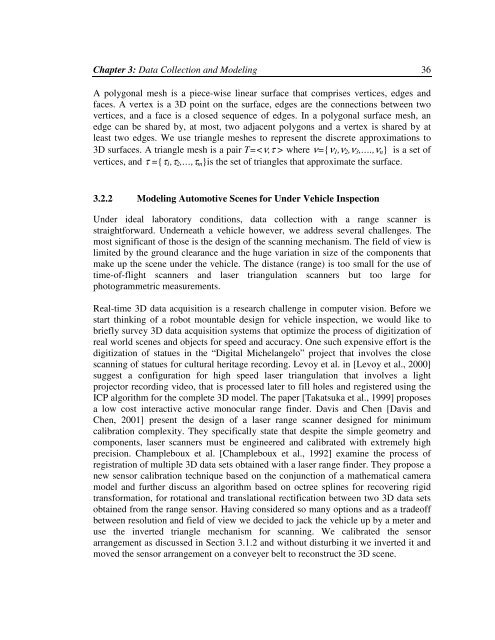To the Graduate Council: I am submitting herewith a thesis written by ...
To the Graduate Council: I am submitting herewith a thesis written by ...
To the Graduate Council: I am submitting herewith a thesis written by ...
Create successful ePaper yourself
Turn your PDF publications into a flip-book with our unique Google optimized e-Paper software.
Chapter 3: Data Collection and Modeling 36A polygonal mesh is a piece-wise linear surface that comprises vertices, edges andfaces. A vertex is a 3D point on <strong>the</strong> surface, edges are <strong>the</strong> connections between twovertices, and a face is a closed sequence of edges. In a polygonal surface mesh, anedge can be shared <strong>by</strong>, at most, two adjacent polygons and a vertex is shared <strong>by</strong> atleast two edges. We use triangle meshes to represent <strong>the</strong> discrete approximations to3D surfaces. A triangle mesh is a pair T= where ν={ν 1 ,ν 2 ,ν 3 ,….,ν n } is a set ofvertices, and τ ={τ 1 ,τ 2 ,…,τ m }is <strong>the</strong> set of triangles that approximate <strong>the</strong> surface.3.2.2 Modeling Automotive Scenes for Under Vehicle InspectionUnder ideal laboratory conditions, data collection with a range scanner isstraightforward. Underneath a vehicle however, we address several challenges. Themost significant of those is <strong>the</strong> design of <strong>the</strong> scanning mechanism. The field of view islimited <strong>by</strong> <strong>the</strong> ground clearance and <strong>the</strong> huge variation in size of <strong>the</strong> components thatmake up <strong>the</strong> scene under <strong>the</strong> vehicle. The distance (range) is too small for <strong>the</strong> use oftime-of-flight scanners and laser triangulation scanners but too large forphotogr<strong>am</strong>metric measurements.Real-time 3D data acquisition is a research challenge in computer vision. Before westart thinking of a robot mountable design for vehicle inspection, we would like tobriefly survey 3D data acquisition systems that optimize <strong>the</strong> process of digitization ofreal world scenes and objects for speed and accuracy. One such expensive effort is <strong>the</strong>digitization of statues in <strong>the</strong> “Digital Michelangelo” project that involves <strong>the</strong> closescanning of statues for cultural heritage recording. Levoy et al. in [Levoy et al., 2000]suggest a configuration for high speed laser triangulation that involves a lightprojector recording video, that is processed later to fill holes and registered using <strong>the</strong>ICP algorithm for <strong>the</strong> complete 3D model. The paper [Takatsuka et al., 1999] proposesa low cost interactive active monocular range finder. Davis and Chen [Davis andChen, 2001] present <strong>the</strong> design of a laser range scanner designed for minimumcalibration complexity. They specifically state that despite <strong>the</strong> simple geometry andcomponents, laser scanners must be engineered and calibrated with extremely highprecision. Ch<strong>am</strong>pleboux et al. [Ch<strong>am</strong>pleboux et al., 1992] ex<strong>am</strong>ine <strong>the</strong> process ofregistration of multiple 3D data sets obtained with a laser range finder. They propose anew sensor calibration technique based on <strong>the</strong> conjunction of a ma<strong>the</strong>matical c<strong>am</strong>er<strong>am</strong>odel and fur<strong>the</strong>r discuss an algorithm based on octree splines for recovering rigidtransformation, for rotational and translational rectification between two 3D data setsobtained from <strong>the</strong> range sensor. Having considered so many options and as a tradeoffbetween resolution and field of view we decided to jack <strong>the</strong> vehicle up <strong>by</strong> a meter anduse <strong>the</strong> inverted triangle mechanism for scanning. We calibrated <strong>the</strong> sensorarrangement as discussed in Section 3.1.2 and without disturbing it we inverted it andmoved <strong>the</strong> sensor arrangement on a conveyer belt to reconstruct <strong>the</strong> 3D scene.
















